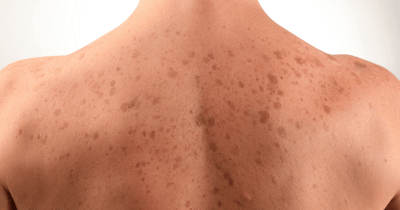As beautiful as the summer sun can be, it’s not always kind to your skin. One of the most common skin concerns triggered by sun exposure is sun spots, those flat, brownish marks that often appear on the face, hands, chest, or shoulders after spending time outdoors.
But are these sun spots permanent? What causes them, and more importantly, how can you prevent and treat them effectively?
In this comprehensive guide, we’ll explore everything you need to know about sun-induced skin discoloration from prevention and skincare to the best clinical treatments available today.

Are Sun Spots Permanent?
Sun spots, also known as solar lentigines, age spots, or sun-induced hyperpigmentation, are caused by prolonged or repeated UV exposure. They are typically flat, round or oval, and brown to dark brown in color. Unlike freckles, which can fade in winter, sun spots are usually persistent and may deepen over time.
However, they are not necessarily permanent. With the right combination of skincare, sun protection, and dermatological treatment, their appearance can be significantly reduced or even completely eliminated.
That said, without consistent protection, new spots may form or old ones may darken again.
How Can Sun Spots Be Treated?
There are several effective methods for fading or removing sun spots, ranging from over-the-counter products to advanced dermatological procedures.
- Topical Treatments:
- Hydroquinone: A skin-lightening agent that reduces melanin production. Available by prescription or in lower concentrations over-the-counter.
- Retinoids (Retinol, Tretinoin): Stimulate cell turnover and lighten pigmentation over time.
- Vitamin C serums: Offer antioxidant protection and gradual brightening.
- Niacinamide: Helps regulate pigment production and soothe inflammation.
- Azelaic acid or kojic acid: Gentle brightening agents suitable for sensitive skin.
- Dermatological Procedures:
- Chemical peels: Use glycolic, lactic, or trichloroacetic acid (TCA) to exfoliate and lift pigmented layers of the skin.
- Laser therapy: Intense Pulsed Light (IPL) or fractional laser targets melanin and breaks it down without damaging surrounding tissue.
- Cryotherapy: Liquid nitrogen is applied to freeze and remove superficial sun spots.
- Microneedling: Boosts collagen production and improves skin tone when combined with brightening serums.
Important: Always consult with a certified dermatologist before starting any treatment, as incorrect use of products or procedures can worsen pigmentation or cause irritation.
How to Prevent Sun Spots From Forming
Sun spots may be stubborn, but they are largely preventable with the right habits. Here’s how to shield your skin from unnecessary damage:
- Daily sunscreen: Use broad-spectrum SPF 30 or higher every day, even on cloudy or winter days.
- Reapply sunscreen every 2 hours, especially after swimming or sweating.
- Wear protective clothing: Hats, sunglasses, and UV-blocking fabrics reduce direct exposure.
- Seek shade: Avoid direct sun between 10 AM and 4 PM when UV radiation peaks.
- Avoid tanning beds: Artificial UV light is just as harmful and accelerates pigmentation.
- Use antioxidant skincare: Vitamin C, E, and ferulic acid help neutralize free radicals generated by sun exposure.
Prevention is far easier and less expensive than treatment. Make sun protection a non-negotiable part of your skincare routine.
Do Spot-Fading Creams Really Work?
The short answer is: yes, with the right ingredients and consistent use.
However, not all creams are created equal. Many commercial products make big promises but contain insufficient active ingredients. For visible improvement, look for:
- Hydroquinone (2%–4%)
- Retinol or retinaldehyde
- L-ascorbic acid (Vitamin C)
- Licorice root extract
- Tranexamic acid
- Niacinamide
For best results:
- Apply at night on clean, dry skin.
- Use SPF diligently during the day these ingredients can make your skin more sun-sensitive.
- Be patient: most topical products take 4–12 weeks to show results.
If over-the-counter options don’t work, your dermatologist may prescribe stronger formulations or recommend in-office treatments.
Are Brown Spots on the Face Caused by the Sun?
In most cases yes. Brown spots on the face, especially on the cheeks, forehead, and nose, are often the result of sun exposure over time. These can take the form of:
- Sun spots (solar lentigines)
- Melasma: Hormonal pigmentation that worsens with sun exposure
- Post-inflammatory hyperpigmentation (PIH): Dark marks left by acne or injury, made worse by UV rays
However, not all brown spots are sun-related. They could also be:
- Age-related liver spots
- Fungal infections (e.g., tinea versicolor)
- Underlying skin conditions
If you’re unsure, always have new or changing spots evaluated by a dermatologist to rule out skin cancer or pre-cancerous lesions.
What Is the Best Dermatological Treatment for Sun Spots?
The best treatment depends on your skin type, depth of pigmentation, and budget. Here’s a quick comparison of the most effective options:
| Treatment | Best For | Pros | Cons |
| IPL (Intense Pulsed Light) | Fair to medium skin tones | Fast results, minimal downtime | May not suit darker skin tones |
| Laser therapy (e.g., Q-switched or Fraxel) | Deep or resistant spots | Precise, long-lasting | More costly, needs multiple sessions |
| Chemical peels | Surface pigmentation | Affordable, improves texture | Requires downtime and aftercare |
| Microneedling with serums | Overall skin rejuvenation | Boosts collagen, safe for all tones | Gradual results |
| Cryotherapy | Single or superficial spots | Quick in-office treatment | Can cause redness or temporary light spots |
Combination therapy often provides the best outcome such as pairing lasers with topical brighteners or peels with antioxidant serums.
Summer Skincare Bonus: How to Enjoy the Sun Without Damage
- Apply SPF 50+ every two hours when sunbathing or swimming
- Add a wide-brimmed hat and polarized sunglasses to your beach bag
- Use after-sun products with aloe vera or panthenol to soothe and repair
- Exfoliate gently (1–2 times per week) to remove dead cells and prevent dullness
- Hydrate your skin inside and out drink plenty of water and use a hyaluronic acid serum
Sun damage accumulates over time, so consistent care is your best defense against discoloration, premature aging, and more serious conditions.
Erdem Hospital Offers Advanced Dermatological Solutions for Skin Clarity and Confidence

If sun spots or hyperpigmentation are affecting your confidence, Erdem Hospital in Istanbul provides state-of-the-art dermatological treatments tailored to your unique skin profile. With over 37 years of medical excellence, our expert dermatologists use a combination of clinical-grade skincare, laser therapy, and chemical peels to treat sun-related pigmentation safely and effectively.
International patients choose Erdem Hospital for high-quality, individualized skin care that delivers visible results with compassion and professionalism. Whether you’re seeking sun spot removal, full facial rejuvenation, or a preventive skincare plan, we’re here to support your skin health season after season.